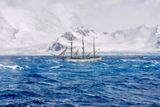Ship Endurance’s Fate Linked to Structural Flaws, Study Reveals

The tragic fate of the ship Endurance may have been sealed before it even reached Antarctica, according to new research. A study led by polar explorer and scientist Jukka Tuhkuri suggests that structural flaws in the ship contributed to its failure against the harsh conditions of the Antarctic. The findings, published in the journal Polar Record, raise questions about the vessel’s design and whether its owner, Sir Ernest Shackleton, was aware of its weaknesses.
Endurance’s Ambitious Voyage and Its Downfall
The Endurance set sail in January 1914 with the ambitious goal of making the first-ever crossing of the Antarctic continent. Unfortunately, the ship became trapped in pack ice after losing its rudder, rendering it immobile. Ultimately, it sank in the Weddell Sea, its wreckage remaining undiscovered for over a century due to year-round ice cover. When the wreck was located in 2022, it was found nearly 10,000 feet below the surface in remarkably preserved condition, now classified as a protected historic monument.
Tuhkuri, a professor of solid mechanics at Aalto University in Finland, seized the opportunity to investigate the ship’s structure. By analyzing expedition diaries, Shackleton’s correspondence, and naval architectural assessments, he uncovered critical insights regarding its vulnerabilities.
Structural Deficiencies Uncovered
Tuhkuri concluded that the Endurance was fundamentally ill-equipped for the brutal conditions it encountered. He stated, “Even simple structural analysis shows that the ship was not designed for the compressive pack ice conditions that eventually sank it.” His comparison with other polar vessels of the time revealed multiple structural deficiencies, including weaker deck beams and frames, an elongated machine compartment that compromised hull integrity, and the absence of diagonal beams for additional support.
“The initial blow came from a damaged keel, but the ultimate cause of destruction lay in the ship’s inability to withstand the immense compressive forces of the Antarctic ice,” Tuhkuri explained in a press release.
Shackleton’s awareness of the ship’s limitations raises further questions. In his correspondence, he expressed frustration over the vessel’s flaws and indicated a preference for a different ship from earlier voyages. He had even recommended diagonal beams for other polar vessels during visits to a Norwegian shipyard, suggesting a level of understanding about the structural requirements for surviving in such harsh environments.
While Tuhkuri noted that Shackleton was likely aware of the Endurance’s shortcomings, the reasons behind his choice of vessel remain speculative. “We can wonder about financial pressures or time constraints, but the truth is, we may never know why Shackleton made the choices that he did. Now, we have more concrete findings to flesh out the stories,” Tuhkuri concluded.
Despite the Endurance not surviving the Antarctic ice, the crew’s survival under Shackleton’s remarkable leadership remains one of the defining moments of the Heroic Age of Antarctic Exploration. The legacy of the expedition continues to inspire and intrigue, even as new research sheds light on the challenges faced by those brave enough to venture into the unknown.






